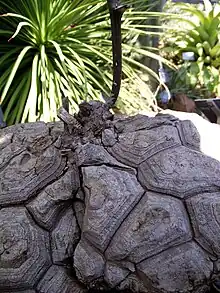Dioscorea mexicana
Dioscorea mexicana, Mexican yam or cabeza de negro is a species of yam in the genus Dioscorea.[1]
| Mexican yam | |
|---|---|
 | |
| Scientific classification | |
| Kingdom: | Plantae |
| Clade: | Tracheophytes |
| Clade: | Angiosperms |
| Clade: | Monocots |
| Order: | Dioscoreales |
| Family: | Dioscoreaceae |
| Genus: | Dioscorea |
| Species: | D. mexicana |
| Binomial name | |
| Dioscorea mexicana Scheidw. | |
| Synonyms[1] | |
| |
Dioscorea mexicana is a caudiciform dioscorea having either a partly to completely above-ground dome-shaped caudex with a thick, woody outer layer up to 3 feet (90 cm) in diameter and 8–10 inches (20 to 25 cm) in height. The caudex of D. mexicana is divided into regular polygonal plates that become protuberant with age, and separated by deep fissures. The vigorous annual vines which may reach 30 feet (9 m) long before dying back in winter, that grow up from the caudex, bear heart-shaped leaves.[2]
Dioscorea mexicana ranges from the state of San Luis Potosí in northeastern Mexico south to Panama.[3][4][5][6][7][8][9] It is notable for its production of diosgenin, which is a precursor for the synthesis of hormones such as progesterone.[10] Russell Marker developed the extraction and manufacture of hormones from D. mexicana at Syntex. Later the Mexican barbasco trade focused instead on Dioscorea composita instead, as this variety has a higher diosgenin content.[11]
References
- "World Checklist of Selected Plant Families: Royal Botanic Gardens, Kew". apps.kew.org. Retrieved 2017-01-23.
- Dortort, Fred(2011). Succulent Plants of the World. Timber Press Inc. pp 220. ISBN 978-0-88192-995-9
- Téllez V., O. & B. G. Schubert. 1994. 251. Dioscoreaceae. 6: 53–65. In G. Davidse, M. Sousa Sánchez & A.O. Chater (eds.) Flora Mesoamericana. Universidad Nacional Autónoma de México, México, D. F.
- Sosa, V., B. G. Schubert & A. Gómez Pompa. 1987. Dioscoreaceae. Flora de Veracruz 53: 1–46.
- Correa A., M.D., C. Galdames & M. Stapf. 2004. Catálogo de las Plantas Vasculares de Panamá 1–599. Smithsonian Tropical Research Institute, Panamá.
- Pérez J., L. A., M. Sousa Sánchez, A. M. Hanan-Alipi, F. Chiang Cabrera & P. Tenorio L. 2005. Vegetación terrestre. 65–110. In J. Bueno, F Álvarez & S. Santiago Biodiversidad del Estado de Tabasco. CONABIO-UNAM, México.
- Balick, M. J., M. H. Nee & D.E. Atha. 2000. Checklist of the vascular plants of Belize. Memoirs of The New York Botanical Garden 85: i–ix, 1–246.
- Nelson Sutherland, C.H. (2008). Catálogo de las plantes vasculares de Honduras. Espermatofitas: 1–1576. SERNA/Guaymuras, Tegucigalpa, Honduras.
- López Patiño, E.J., Szeszko, D.R., Rascala Pérez, J. & Beltrán Retis, A.S. (2012). The flora of the Tenacingo-Malinalco-Zumpahuacán protected natural area, state of Mexico, Mexico. Harvard Papers in Botany 17: 65–167.
- "Dioscorea mexicana". Germplasm Resources Information Network. Agricultural Research Service, United States Department of Agriculture. Retrieved 10 January 2018.
- "americanheritage.com". Archived from the original on 2010-09-25. Retrieved 2008-08-05.
External links